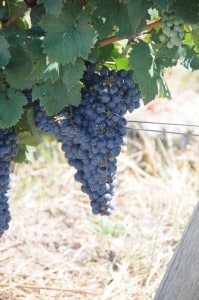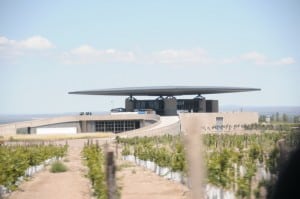 Today I was booked on a winery tour in Mendoza. The lure of the grapes had started in the north of Argentina with my visit to Cafayete. 160kms north of Mendoza once again I was tempted as we drove through the fertile San Juan region.
Today I was booked on a winery tour in Mendoza. The lure of the grapes had started in the north of Argentina with my visit to Cafayete. 160kms north of Mendoza once again I was tempted as we drove through the fertile San Juan region.
Today’s tour was about trying the flagship grape varietal of Mendoza, the famous Malbec. For us Kiwi’s and Aussies we seldom drink a pure Malbec wine, we know this best as an additive in small quantities (10-15%) in blends in Australasia and Europe. With 2000 wineries in the Mendoza area the idea of where to start becomes daunting this improves when you find out that only 80 open their door to the public. Still 80 is too hard and driving the bike was definitely out of the question. So it was down to the experts to see what was on offer. I chose Ampora Wine Tours they based one of their tours in the Uco Valley around 1.5 hours south of Mendoza just outside the small town of Tunuyan. It was reported that the Uco valley a relatively new region was boasting some of the best Sauvignon Blanc’s and Pinot Nior’s. I found that hard to believe given the NZ pedigree.
Mendoza is a desert area that relies on the melted snow from the Andes for all its water supply. The demand for water for domestic use and agriculture is quite a controversial topic for the people who live in Mendoza. The main river “Rio Mendoza” is fully dammed and no longer flows on the outskirts of Mendoza, further development in the agriculture sector is threatening the further damming of the other Ande tributaries. I could only imagine what the consequences may be if they had a mild winter.
So what makes Mendoza and Malbec so special? Well it turns out that it all comes down to it’s fantastic climate, the area gets at least 300 days of sunshine and only 250mm of rain per year. This in terms of grape growing is fantastic as the quality of the yield remains constant unlike NZ, Aussie and Europe where each year can vary so much. The only downside to the Mendoza climate is the hail which occurs during the months of December and January.
Anyway on to the tour. The Uco valley is similar to that of central Otago a high altitude vineyard (1300m) with hot days and cool nights. Winter brings snow and the threat of frost but a gentle constant wind prevents this. Under these conditions the grapes form a hard skin providing a very succulent product. We visited three wineries Andeluna, Salentien and O’Fournier. These were relatively new wineries with a lot of their vines planted around 2000 giving them production over the last couple of years with a lot of the wine still in Barrel or bottle ready for release.
 On arrival at these vineyards I was blown away with the architecture, technology and investment that was present in these facilities. I had not seen this in any of the many vineyards I have visited in Australia or New Zealand. Each of the facilities were based on a gravitational wine flow principle. Grapes were added at the top and worked their way down through the cold press process, juice to be transferred gravitationally down for fermentation, barrelling and finally bottling then cellaring. No pumps were used at all to avoid the introduction of air in the wine. Now to achieve this one must start by digging a big hole and build a 5 story facility in the ground. The advantage being that natural cellaring occurs on the bottom floor.
On arrival at these vineyards I was blown away with the architecture, technology and investment that was present in these facilities. I had not seen this in any of the many vineyards I have visited in Australia or New Zealand. Each of the facilities were based on a gravitational wine flow principle. Grapes were added at the top and worked their way down through the cold press process, juice to be transferred gravitationally down for fermentation, barrelling and finally bottling then cellaring. No pumps were used at all to avoid the introduction of air in the wine. Now to achieve this one must start by digging a big hole and build a 5 story facility in the ground. The advantage being that natural cellaring occurs on the bottom floor.
These were truly amazing facilities I cannot imagine how one gets a return on such an investment. Who in Argentina spends this type of money, the answer is no one. It turns out that all these modern facilities are all foreign owned. Most began as joint ventures with local Argentines giving access to local cheap labour and knowledge. Today most of the ownership has reverted to the Americian, Spanish and Dutch ownership.
Well what about the wine. ? My focus was the Malbec and reserve blends of Malbec (at least 60% plus) and Merlot or Cabinet Sauvignon. They were outstanding and given the age of the vines I would say that the Mendosa area has a fantastic future. I then turned my attention to the Sauvignon Blanc and Pinot Noir. These were stunning and I am sure in a blind tasting these would stack up against NZ finest. When asked how much I thought these were I suggested primo prices similar to Peregrine or Oyster Bay. To my surprise these where 16 Peso’s a bottle, $5 NZD a bottle. Wow how could this be, it all came down to the base labour price. All grapes were handpicked with the average picker completing 80 skips (a skip being 18kgs of grapes) a day and being paid 0.80 pesos per skip. His take home pay being $22NZD per day!!.
So in summary, cheap labour, handpicked grapes, excellent quality, state of art winemaking and 300 days of sun is a fantastic recipe for high quality wine manufacture. I am sure with age the Uco valley and Mendoza will rise to become one of the world top wine regions.
For me personally I prefer the Aussie blends with Shiraz or Cabinet Sauvignon as their base.

Comments are closed.